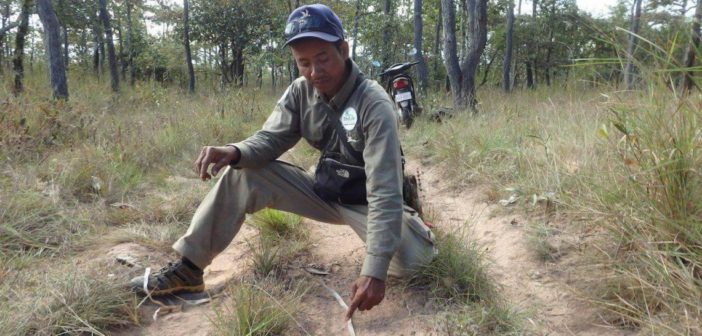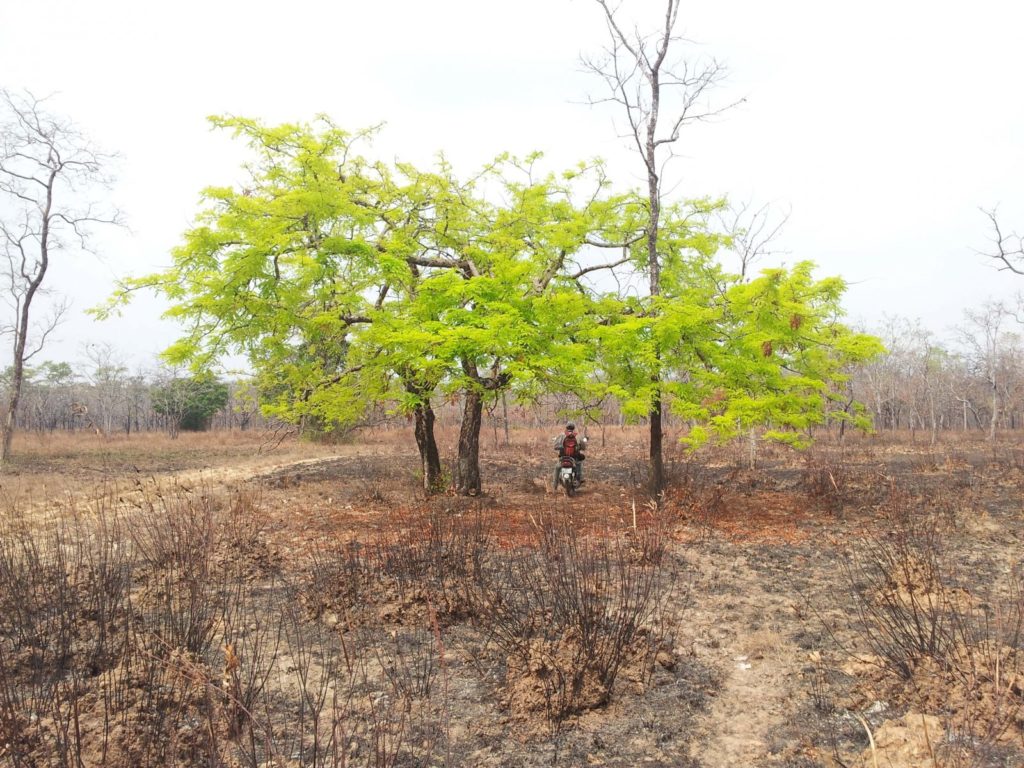Written by Shaun Hurrell
Mem Mai kicks his motorbike into gear, the rear tire squirming in sandy soil as he accelerates, binoculars proudly hooked over his shoulder. This motorbike would look more apt on the busy streets of Phnom Penh, but if you’re skilled it is the best way to negotiate the rooty, open terrain of Western Siem Pang Wildlife Sanctuary in northern Cambodia. Today Mai can be found monitoring the state of the forest pools, which are a lifeline for wildlife during the dry season, including the two critically endangered ibis species that live here. Later he stops near a tree with a slender-billed vulture nest; still one healthy chick today, he records in his pocket notebook.
Out in the forest Mai is in his element: his eyes scan the undergrowth like a startled deer, yet his posture and face radiate calmness. It’s well known that Mai’s attuned ears can pick out the calls of specific songbird species above the noise of a moving motorbike. Such skills can’t be mastered during a university degree. Born in a rural village where most inhabitants live under the poverty line, Mai used to be a hunter.
This is his story:
“I was born to a very poor family in the village of Khes Svay, just next to the Western Siem Pang Wildlife Sanctuary. With the willingness to support myself and my family, as a young adult I enrolled in the army in 1988. There, for two years, I learned how to use weapons and, after I returned home, became a hunter. At that time, the most popular hunting equipment consisted of a rifle, traps and snares, all of which we would build ourselves. The handmade rifle we used for hunting wild pig, sambar deer, red muntjac, Eld’s deer, water monitor, Bengal monitor, civet, rabbit, turtle, and more [some of which are endangered]. But our most precious target was the tiger (widely present in Cambodia at the time, before becoming nationally extinct in 2007).
“In 1993, I finally reached my target and killed a tiger.”
“To this day I still remember the horrible sound it made when it died. The meat of the kill fed my family, some was shared with neighbors, and the remains such as the skin were exchanged in the village for basic necessities. I quickly became a middleman, killing and selling wildlife to neighboring Laos. Sadly, I saw the last tiger in the area back in 1993. I can vividly remember the encounter; it was around 3pm and I saw it for several minutes not so far away.
“Then, in 2003, I heard about a work opportunity with the NGO, BirdLife International. They were looking for bird researchers and needed people with an in-depth knowledge of the Wildlife Sanctuary. I was really interested and ended up being recruited. I left my life as a hunter behind to become a conservationist.
“Before, my only option was to kill wildlife to earn an income. Even though at the beginning I only received $20 per month for a few small tasks, now I could contribute to a positive change. I somehow realized that if we did not change, soon all the wildlife would be hunted to extinction and my children would never be able to see the same wonderful things in nature as I have. In the past 15 years, I have learned all about wildlife ecology, characteristics of a productive season, incubating, hatching, feeding, and the general activities of wildlife.
“Today I am a full-time Senior Field researcher for BirdLife, and I can recognize hundreds of bird species just by hearing their call. I have a profound love for nature and I wish to help protect it. Wild animals are not so different from human beings, so why should we kill them?
“This unexpected path in my life has led me to become a well-known and respected person in my village. They elected me as Deputy Village Chief, and then as Deputy Commune Chief, but I turned down both positions. I know my heart belongs to the field, and to the conservation of wildlife.
“I hope that at least one or two of my sons will also find a job in nature conservation. As my father told me: ‘The life of a tree is often close to the trunk.’ However, in the end it is up to my children to decide what they want to do in life, and I accept that. It is important that we continue to educate the young generation in nature conservation, as it is easier for them to learn how to appreciate our forest and all the animals. We have to try harder to make them love wildlife.”
Based on an interview by Chea Sophea, BirdLife Cambodia. Thanks to the MacArthur Foundation and Fondation Segré for supporting BirdLife Cambodia’s biodiversity research work. BirdLife Cambodia’s crucial work at Western Siem Pang will be supported by the 2019 British Birdwatching Fair.
Featured image: Mem Mai on his rounds. © Chea Sophea








